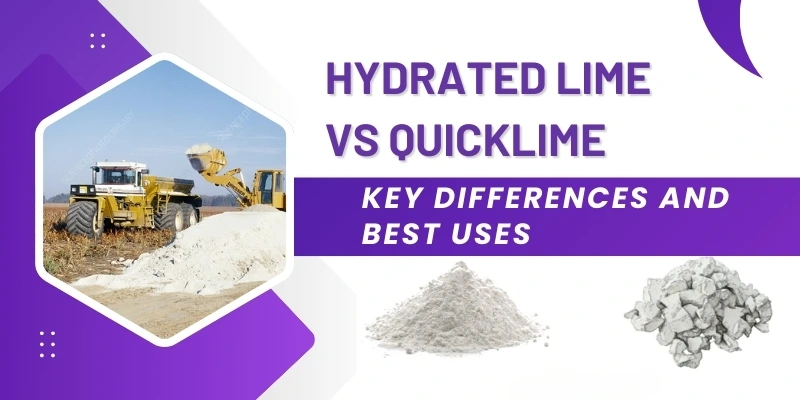
Hydrated Lime vs. Quicklime: Key Differences and Best Uses
Lime is an essential material in various industries, from construction to agriculture and water treatment. Two commonly used forms of lime are hydrated lime and quicklime. Hydrated lime, commonly represented by the hydrated lime formula Ca(OH)₂, and quicklime both originate from limestone, but they differ in composition, properties, and applications. Understanding the differences between these two materials can help determine the best option for specific uses.
What is Quicklime?
Quicklime, also known as calcium oxide (CaO), is a highly reactive white powder or granular substance produced by heating limestone at high temperatures in a process called calcination. This process removes carbon dioxide (CO₂) from limestone, leaving behind quicklime.
Quicklime Benefits
- 1. Highly Reactive: Quicklime reacts vigorously with water, releasing heat in an exothermic reaction.
- 2. Versatile in Industrial Use: It is widely used in steel manufacturing, chemical processing, and environmental applications.
- 3. Efficient in pH Control: Quicklime effectively neutralizes acidic soils and wastewater.
- 4. Reduces Pollutants: It plays a significant role in flue gas treatment by capturing sulfur dioxide.
- 5. Stronger Binding Properties: Quicklime enhances the strength of cement and mortar in construction.
What is Hydrated Lime?
Hydrated lime, or calcium hydroxide (Ca(OH)₂), is created by adding water to quicklime in a controlled process known as slaking. This results in a fine, dry powder with lower reactivity but increased usability in various industries.
Hydrated Lime Applications
- 1. Water Treatment: It is widely used in drinking water purification and wastewater treatment to remove impurities.
- 2. Construction: Hydrated lime improves workability, durability, and moisture resistance in cement and plaster.
- 3. Agriculture: Farmers use hydrated lime to adjust soil pH, enhance plant growth, and improve nutrient absorption.
- 4. Food Industry: It is used in food processing, such as in the preparation of corn tortillas and sugar refining.
- 5. Leather Industry: Hydrated lime helps in the removal of hair and impurities from animal hides during leather processing.
Key Differences Between Hydrated Lime and Quicklime
| Property | Quicklime (Calcium Oxide) | Hydrated Lime (Calcium Hydroxide) |
|---|---|---|
| Chemical Formula | CaO | Ca(OH)₂ |
| Production | Produced by heating limestone | Produced by adding water to quicklime |
| Reactivity | Highly reactive, generates heat when mixed with water | Less reactive, safer to handle |
| Uses | Steelmaking, pollution, control, soil stabilization | Water treatment, agriculture, food industry |
| Handling | Requires careful handling due to heat generation | Easier and safer to use |
Best Uses of Hydrated Lime and Quicklime
- ● For Construction: Quicklime is preferred for its strength-enhancing properties, while hydrated lime is better for improving workability and durability.
- ● For Agriculture: Hydrated lime is the better choice for adjusting soil pH as it is easier to apply and control.
- ● For Water Treatment: Hydrated lime is commonly used because of its effectiveness in removing contaminants without generating excessive heat.
- ● For Industrial Applications: Quicklime is more effective for high-temperature and chemical processes, such as steel manufacturing and gas purification.
Conclusion
Both hydrated lime and quicklime serve essential purposes in different industries. While quicklime benefits industries that require high reactivity and heat generation, hydrated lime applications are more diverse due to its ease of handling and controlled reactivity. Choosing the right type of lime depends on specific requirements, safety considerations, and the intended application.